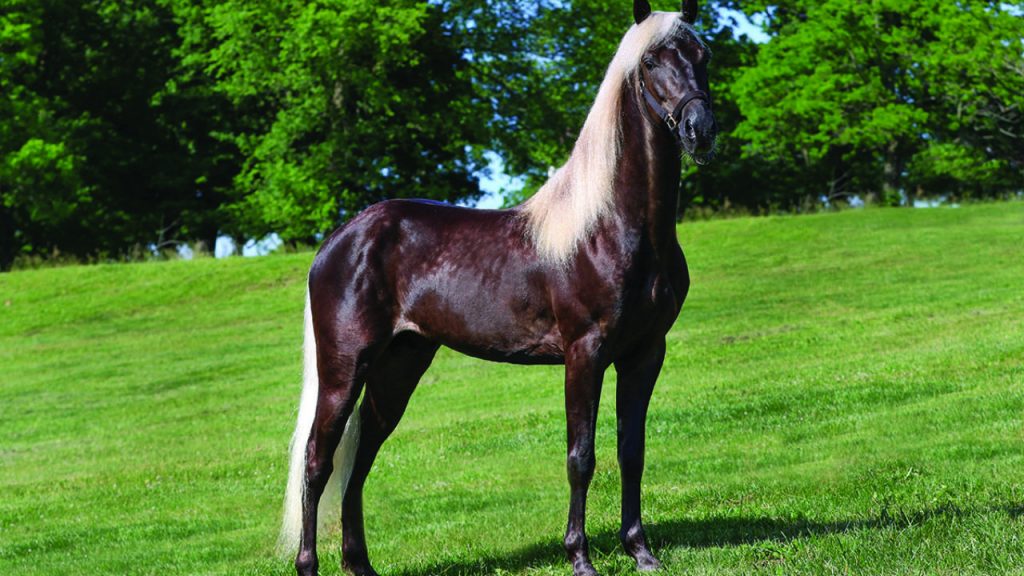The Kentucky Mountain Horse is such a unique and interesting breed! These horse originated in the Appalachian Mountains of Kentucky, and they were bred for their hardiness, endurance, and sure-footedness. They’re also known for their beautiful, flowing manes and tails.
History
Although the exact origins of this breed are unknown, the Mountain Pleasure Horse, the oldest gaited breed in North America and the parent breed of the Tennessee Walker, Rocky Mountain Horse, and American Saddlebred, is believed to be the breed’s ancestor. Its lineage is also associated with the Narragansett Pacers, a robust and agile horse that was introduced by the settlers who settled in the eastern region of Kentucky in the eighteenth century, close to the Appalachian Mountains. This breed was created by farmers who wanted to use it for both working and riding purposes. They were employed for long-distance travel over rugged terrain in areas with limited grazing. It was simple because of their kind and endearing disposition.
The utility of the Kentucky Mountain Saddle Horse for riding continues even in the present as they excel as perfect trail mounts for traveling in the rugged terrain.
Breed standards
Robert Robinson Jr. founded the Kentucky Mountain Saddle Horse Association (KMSHA) in 1989 with the intention of recording, conserving, and advancing this breed. As of 2011, there were 24,000 registered breeds and 3200 members overall. The Spotted Mounted Horse Association (SMHA) was established in 2002 as a division of the KMSHA with the aim of registering horses with a pinto pattern, a bald or entirely white face, and white pigmentation above the knees or hocks for registration. Solid-colored foals registered with the Spotted Mountain Horse Association may register under the same association as their parents. Conversely, however, geldings that are solid colored, born of SMHA registered parents are eligible for registration with the KMSHA, though dual registration is not permitted.
Foals born to registered KMSHA parents receive a temporary registration after birth, which becomes permanent prior to the foal’s first breeding or before it reaches four years of age, whichever comes first. One of the primary requirements for registration with this organization is that the horses must be taller than eleven hands; breeds that reach this size are classified into two groups: Class A horses are taller than 14.1 hands, while Class B horses fall between 11 and 14.1 hands. Additionally, the horses must exhibit a natural four-beat gait and a calm, gentle temperament in front of the evaluators.
Mares and stallions born of parents who are not registered with the KMSHA will be a part of the main stud book only if they (parents) are registered with the Mountain Pleasure Horse Association, Kentucky Naturally Gaited Horse Association or the Rocky Mountain Horse Association.
Temperament
one of the notable characteristics of the Kentucky Mountain Saddle Horse is its gentle, even-tempered nature. These horses are known for being calm, friendly, and willing to please. They’re also intelligent and trainable, making them a great choice for both beginners and experienced riders. Additionally, they’re known for their stamina and sure-footedness, making them well-suited fo work in mountains.
Overall Description
Despite having a small to medium-sized frame, Kentucky Mountain Saddle Horses are remarkably athletic, graceful, and robust. It will be evident to you that this horse has elegant, slender legs and is very athletic and sure-footed. Three gaits are also included in it: walk, single-foot or amble, and canter.
The ears should be medium in size and well-shaped, the eyes should be bold but soft, and the profile should be flat. In addition, the mane should be long and flowing, and the neck should be attractive and medium in length and width. The chest should be broad and deep, and the shoulders should be properly sloping.
The Kentucky Mountain Saddle Horse is easygoing and social.
Grooming Requirements
The Kentucky Mountain Saddle Horse has special grooming requirements due to its unique coat and mane. The coat should be groomed regularly with a curry comb and brush, and the mane should be kept long and flowing. Many owners choose to braid the mane in order to keep it tangle-free.
Standard horse grooming tools will be sufficient to keep your horse’s coat smooth, shiny, and free of dirt, mud, and other debris. Use a hoof pick to clean out the horse’s hooves after riding, and utilize a curry comb to remove any loose hair and debris that has collected in the coat. Other tools, including a dandy brush, body finishing brush, and shedding blade, can further remove debris and excess hair.
Health care
The Kentucky Mountain Saddle Horse is a relatively hardy breed, but is still require veterinary care and maintenance. Like all horses, the Kentucky Mountain Saddle Horse needs routine vaccinations and deworming. It’s important to regularly check the horse’s hooves and teeth, and to make sure it has a proper diet. These horses are also prone to a condition called Equine Metabolic Syndrome, so it’s important to be aware of the signs and symptoms of this disease.
Diet
The diet of the Kentucky Mountain Saddle Horse should consist primarily of forage, such as grass hay or pasture. These horses should also have access to clean, fresh water at all times. In addition, they can benefit from a small amount of high quality grain or a ration balancer. Some owners also choose to supplement their horses’ diets with vitamin E and selenium, which can help support a healthy immune system.

